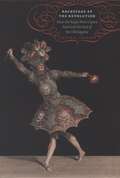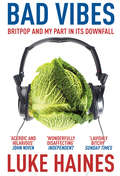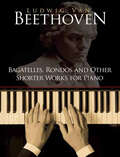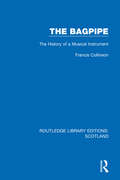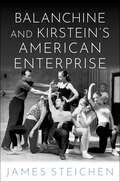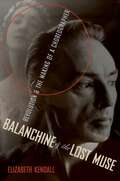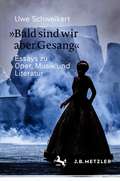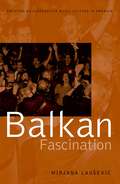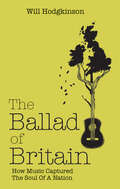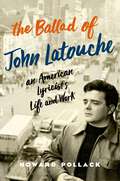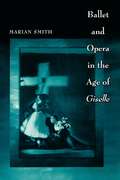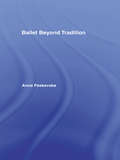- Table View
- List View
Backstage At The Revolution (PDF): How The Royal Paris Opera Survived The End Of The Old Regime
by Victoria JohnsonOn July 14, 1789, a crowd of angry French citizens en route to the Bastille broke into the Paris Opera and helped themselves to any sturdy weapons they could find. Yet, despite its long association with the royal court, its special privileges, and the splendor of its performances, the Opera itself was spared, even protected, by Revolutionary officials. Victoria Johnson's "Backstage at the Revolution" tells the story of how this legendary opera house, despite being a lightning rod for charges of tyranny and waste, weathered the most dramatic political upheaval in European history.Sifting through royal edicts, private letters, and Revolutionary records of all kinds, Johnson uncovers the roots of the Opera's survival in its identity as a uniquely privileged icon of French culture - an identity established by the conditions of its founding one hundred years earlier under Louis XIV. Johnson's rich cultural history moves between both epochs, taking readers backstage to see how a motley crew of singers, dancers, royal ministers, poet entrepreneurs, shady managers, and the king of France all played a part in the creation and preservation of one of the world's most fabled cultural institutions.
Bad Music: The Music We Love to Hate
by Christopher Washburne Maiken DernoWhy are some popular musical forms and performers universally reviled by critics and ignored by scholars-despite enjoying large-scale popularity? How has the notion of what makes "good" or "bad" music changed over the years-and what does this tell us about the writers who have assigned these tags to different musical genres? Many composers that are today part of the classical "canon" were greeted initially by bad reviews. Similarly, jazz, country, and pop musics were all once rejected as "bad" by the academy that now has courses on these and many other types of music. This book addresses why this is so through a series of essays on different musical forms and performers. It looks at alternate ways of judging musical performance beyond the critical/academic nexus, and suggests new paths to follow in understanding what makes some music "popular" even if it is judged to be "bad." For anyone who has ever secretly enjoyed ABBA, Kenny G, or disco, Bad Music will be a guilty pleasure!
Bad Music: The Music We Love to Hate
by Christopher J. Washburne Maiken DernoWhy are some popular musical forms and performers universally reviled by critics and ignored by scholars-despite enjoying large-scale popularity? How has the notion of what makes "good" or "bad" music changed over the years-and what does this tell us about the writers who have assigned these tags to different musical genres? Many composers that are today part of the classical "canon" were greeted initially by bad reviews. Similarly, jazz, country, and pop musics were all once rejected as "bad" by the academy that now has courses on these and many other types of music. This book addresses why this is so through a series of essays on different musical forms and performers. It looks at alternate ways of judging musical performance beyond the critical/academic nexus, and suggests new paths to follow in understanding what makes some music "popular" even if it is judged to be "bad." For anyone who has ever secretly enjoyed ABBA, Kenny G, or disco, Bad Music will be a guilty pleasure!
Bad Seed: The Biography of Nick Cave
by Ian JohnstonA widely acclaimed biography of one of rock's most compelling, uncompromising and influential singer-songwriters, Ian Johnston's BAD SEED offers a superb overview of Nick Cave's career to date. Through Cave's fronting of the incendiary bands The Birthday Party and The Bad Seeds, producing music of unfettered expression and explosive intensity, to his creative collaborations outside of the rock industry in film and literature, BAD SEED illustrates a life lived in barely controlled chaos: and unravels the motivation and unique appeal of a reluctant icon whose songs, according to the Rolling Stones, possess "the authority of the most primal kind of myth."
Bad Vibes: Britpop and my part in its downfall
by Luke HainesForget Blur/Oasis and Cool Britannia. None of that actually happened. Bad Vibes is the true story of English Rock in the nineties. Written with wit, brio and no small amount of bile, Luke Haines recounts how it felt to ride a wave of self-congratulatory success in a world with no taste. As frontman of The Auteurs, Haines tells of supporting Suede, conquering France, and failing to break America. Of knuckle-headed musos , baffling tours and a swiftly unravelling personal life. And of what it's like to be on the cusp of massive success. Funny, honest and ridiculously entertaining, Luke Haines attacks anyone within rifle range, and is more than happy to turn the gun on himself. Bad Vibes is a brilliant memoir from a man who tells it how it was - and how he wishes it hadn't been.
Bad Vibrations: The History of the Idea of Music as a Cause of Disease (The History of Medicine in Context)
by James KennawayMusic has been used as a cure for disease since as far back as King David's lyre, but the notion that it might be a serious cause of mental and physical illness was rare until the late eighteenth century. At that time, physicians started to argue that excessive music, or the wrong kind of music, could over-stimulate a vulnerable nervous system, leading to illness, immorality and even death. Since then there have been successive waves of moral panics about supposed epidemics of musical nervousness, caused by everything from Wagner to jazz and rock 'n' roll. It was this medical and critical debate that provided the psychiatric rhetoric of "degenerate music" that was the rationale for the persecution of musicians in Nazi Germany and the Soviet Union. By the 1950s, the focus of medical anxiety about music shifted to the idea that "musical brainwashing" and "subliminal messages" could strain the nerves and lead to mind control, mental illness and suicide. More recently, the prevalence of sonic weapons and the use of music in torture in the so-called War on Terror have both made the subject of music that is bad for the health worryingly topical. This book outlines and explains the development of this idea of pathological music from the Enlightenment until the present day, providing an original contribution to the history of medicine, music and the body.
Bad Vibrations: The History of the Idea of Music as a Cause of Disease (The History of Medicine in Context)
by James KennawayMusic has been used as a cure for disease since as far back as King David's lyre, but the notion that it might be a serious cause of mental and physical illness was rare until the late eighteenth century. At that time, physicians started to argue that excessive music, or the wrong kind of music, could over-stimulate a vulnerable nervous system, leading to illness, immorality and even death. Since then there have been successive waves of moral panics about supposed epidemics of musical nervousness, caused by everything from Wagner to jazz and rock 'n' roll. It was this medical and critical debate that provided the psychiatric rhetoric of "degenerate music" that was the rationale for the persecution of musicians in Nazi Germany and the Soviet Union. By the 1950s, the focus of medical anxiety about music shifted to the idea that "musical brainwashing" and "subliminal messages" could strain the nerves and lead to mind control, mental illness and suicide. More recently, the prevalence of sonic weapons and the use of music in torture in the so-called War on Terror have both made the subject of music that is bad for the health worryingly topical. This book outlines and explains the development of this idea of pathological music from the Enlightenment until the present day, providing an original contribution to the history of medicine, music and the body.
Bagatelles, Rondos and Other Shorter Works for Piano
by Ludwig Van BeethovenUniversally recognized for his critically important role in raising instrumental music to its highest plane, Beethoven is also highly regarded for his leadership in developing and extending the piano repertoire. His bagatelles, once described by the composer himself as "Kleinigkeiten" -- or "trifles" -- are short, masterful works that have proved tremendously popular not only for their pleasing sounds but also for the technical challenges they offer intermediate as well as advanced piano students.This superb, high-quality collection, reproduced from the authoritative Breitkopf & Härtel edition, contains the composer's most popular and most performed bagatelles, rondos, and shorter compositions, including: Six Minuets (c. 1795); the Polonaise in C, Op. 89 (1814); Six Bagatelles, Op. 126 (1823-24); the famed Rondo a capriccio in G (Rage Over a Lost Penny, 1795); the Andante in F (Andante favori, 1803), and a generous selection of other short works. An easily affordable volume, the present edition provides Beethoven devotees, students, teachers, and music lovers with a delightful sampling of a number of spirited works by one of the music world's supreme masters.
The Bagpipe: The History of a Musical Instrument (Routledge Library Editions: Scotland #9)
by Francis CollinsonOriginally published in 1975, and written by an authority on Scottish music, this book traces the evolution of the bagpipe whilst also narrating the fortunes of the ‘Great Highland Bagpipe’ itself. Exploring history and archaeology of civilizations as far removed from the Scottish Highlands as Egypt and Mesopotamia, Greece and Rome this book offers a unique full-length history of one of the world’s most interesting and ancient musical instruments. Appendices list the bagpipes of other countries and the materials used in the instrument’s manufacture as well as a comprehensive bibliography.
The Bagpipe: The History of a Musical Instrument (Routledge Library Editions: Scotland #9)
by Francis CollinsonOriginally published in 1975, and written by an authority on Scottish music, this book traces the evolution of the bagpipe whilst also narrating the fortunes of the ‘Great Highland Bagpipe’ itself. Exploring history and archaeology of civilizations as far removed from the Scottish Highlands as Egypt and Mesopotamia, Greece and Rome this book offers a unique full-length history of one of the world’s most interesting and ancient musical instruments. Appendices list the bagpipes of other countries and the materials used in the instrument’s manufacture as well as a comprehensive bibliography.
Bagpipes (large print)
by RnibThis is an image of Scottish bagpipes, a traditional musical instrument. There is a locator dot shown which will be at the top left of the page when the image is the correct way up. The image shows a set of Scottish bagpipes, comprised of a bag, a chanter, a blowpipe, and three drones.The bag is in the bottom centre of the page. To the left, in the bottom left corner of the page is the chanter. It has seven fingering holes. Up the page from the bag are from left to right: the blowpipe, the bass drone, and two tenor drones. The three drones are connected by a cord, which links each of their tops. There are two decorative tassels on each end of the cord, one to the right of the bass drone and one to the right of the tenor drone on the right. The bagpipes are held against the players body with the bag under the right elbow. The blowpipe is held in the players mouth and the chanter in both hands with fingers covering the holes. The bagpipes are filled with air by bowing into the blowpipe. The air is squeezed out through reeds in the chanter and the drone pipes, which all produce musical notes. The drones each produce only one note. The melody is played on the chanter by covering different combinations of holes.
Bagpipes (UEB contracted)
by RnibThis is an image of Scottish bagpipes, a traditional musical instrument. There is a locator dot shown which will be at the top left of the page when the image is the correct way up. The image shows a set of Scottish bagpipes, comprised of a bag, a chanter, a blowpipe, and three drones.The bag is in the bottom centre of the page. To the left, in the bottom left corner of the page is the chanter. It has seven fingering holes. Up the page from the bag are from left to right: the blowpipe, the bass drone, and two tenor drones. The three drones are connected by a cord, which links each of their tops. There are two decorative tassels on each end of the cord, one to the right of the bass drone and one to the right of the tenor drone on the right. The bagpipes are held against the players body with the bag under the right elbow. The blowpipe is held in the players mouth and the chanter in both hands with fingers covering the holes. The bagpipes are filled with air by bowing into the blowpipe. The air is squeezed out through reeds in the chanter and the drone pipes, which all produce musical notes. The drones each produce only one note. The melody is played on the chanter by covering different combinations of holes.
Bagpipes (UEB uncontracted)
by RnibThis is an image of Scottish bagpipes, a traditional musical instrument. There is a locator dot shown which will be at the top left of the page when the image is the correct way up. The image shows a set of Scottish bagpipes, comprised of a bag, a chanter, a blowpipe, and three drones.The bag is in the bottom centre of the page. To the left, in the bottom left corner of the page is the chanter. It has seven fingering holes. Up the page from the bag are from left to right: the blowpipe, the bass drone, and two tenor drones. The three drones are connected by a cord, which links each of their tops. There are two decorative tassels on each end of the cord, one to the right of the bass drone and one to the right of the tenor drone on the right. The bagpipes are held against the players body with the bag under the right elbow. The blowpipe is held in the players mouth and the chanter in both hands with fingers covering the holes. The bagpipes are filled with air by bowing into the blowpipe. The air is squeezed out through reeds in the chanter and the drone pipes, which all produce musical notes. The drones each produce only one note. The melody is played on the chanter by covering different combinations of holes.
Balanchine and Kirstein's American Enterprise
by James SteichenIn 1933 choreographer George Balanchine and impresario Lincoln Kirstein embarked on an elusive quest to found a ballet company and school in the United States. Though their efforts would eventually result in the creation of the New York City Ballet and the School of American Ballet, the first decade of their collaborative efforts was anything but assured. Tracing the tangled histories of two of the most important figures in twentieth-century dance, Balanchine and Kirstein's American Enterprise offers a fresh perspective on a pivotal period in cultural history. Deeply researched using sources only made available in recent years, the book challenges the mythologies surrounding the early years of the Balanchine-Kirstein enterprise. It also reveals the full extent of Kirstein's essential role and offers reconstructive analysis of lost works, as well as new and surprising details regarding some of Balanchine's most iconic ballets, including Serenade, Apollo, and Concerto Barocco. This history involved artists including Richard Rodgers, Martha Graham, George Gershwin, Katherine Dunham, Vera Zorina, and Igor Stravinsky, as well as dozens of lesser known players whose contributions have yet to be fully acknowledged. Capturing the full sweep of Balanchine and Kirstein's collaborative work across multiple genres and institutions, this book reveals their partnership in all of its exciting and ungainly complexity, showing how the 1930s Balanchine was not the artist that he would eventually become, and how the same was true of the institutions that he and Kirstein jointly created.
Balanchine and Kirstein's American Enterprise
by James SteichenIn 1933 choreographer George Balanchine and impresario Lincoln Kirstein embarked on an elusive quest to found a ballet company and school in the United States. Though their efforts would eventually result in the creation of the New York City Ballet and the School of American Ballet, the first decade of their collaborative efforts was anything but assured. Tracing the tangled histories of two of the most important figures in twentieth-century dance, Balanchine and Kirstein's American Enterprise offers a fresh perspective on a pivotal period in cultural history. Deeply researched using sources only made available in recent years, the book challenges the mythologies surrounding the early years of the Balanchine-Kirstein enterprise. It also reveals the full extent of Kirstein's essential role and offers reconstructive analysis of lost works, as well as new and surprising details regarding some of Balanchine's most iconic ballets, including Serenade, Apollo, and Concerto Barocco. This history involved artists including Richard Rodgers, Martha Graham, George Gershwin, Katherine Dunham, Vera Zorina, and Igor Stravinsky, as well as dozens of lesser known players whose contributions have yet to be fully acknowledged. Capturing the full sweep of Balanchine and Kirstein's collaborative work across multiple genres and institutions, this book reveals their partnership in all of its exciting and ungainly complexity, showing how the 1930s Balanchine was not the artist that he would eventually become, and how the same was true of the institutions that he and Kirstein jointly created.
Balanchine & the Lost Muse: Revolution & the Making of a Choreographer
by Elizabeth KendallHere is the first dual biography of the early lives of two key figures in Russian ballet: famed choreographer George Balanchine and his close childhood friend and extraordinary ballerina Liidia (Lidochka) Ivanova. Tracing the lives and friendship of these two dancers from years just before the 1917 Russian Revolution to Balanchine's escape from Russia in 1924, Elizabeth Kendall's Balanchine & the Lost Muse sheds new light on a crucial flash point in the history of ballet. Drawing upon extensive archival research, Kendall weaves a fascinating tale about this decisive period in the life of the man who would become the most influential choreographer in modern ballet. Abandoned by his mother at the St. Petersburg Imperial Ballet Academy in 1913 at the age of nine, Balanchine spent his formative years studying dance in Russia's tumultuous capital city. It was there, as he struggled to support himself while studying and performing, that Balanchine met Ivanova. A talented and bold dancer who grew close to the Bolshevik elite in her adolescent years, Ivanova was a source of great inspiration to Balanchine--both during their youth together, and later in his life, after her mysterious death just days before they had planned to leave Russia together in 1924. Kendall shows that although Balanchine would have a great number of muses, many of them lovers, the dark beauty of his dear friend Lidochka would inspire much of his work for years to come. Part biography and part cultural history, Balanchine & the Lost Muse presents a sweeping account of the heyday of modern ballet and the culture behind the unmoored ideals, futuristic visions, and human decadence that characterized the Russian Revolution.
Balanchine & the Lost Muse: Revolution & the Making of a Choreographer
by Elizabeth KendallHere is the first dual biography of the early lives of two key figures in Russian ballet: famed choreographer George Balanchine and his close childhood friend and extraordinary ballerina Liidia (Lidochka) Ivanova. Tracing the lives and friendship of these two dancers from years just before the 1917 Russian Revolution to Balanchine's escape from Russia in 1924, Elizabeth Kendall's Balanchine & the Lost Muse sheds new light on a crucial flash point in the history of ballet. Drawing upon extensive archival research, Kendall weaves a fascinating tale about this decisive period in the life of the man who would become the most influential choreographer in modern ballet. Abandoned by his mother at the St. Petersburg Imperial Ballet Academy in 1913 at the age of nine, Balanchine spent his formative years studying dance in Russia's tumultuous capital city. It was there, as he struggled to support himself while studying and performing, that Balanchine met Ivanova. A talented and bold dancer who grew close to the Bolshevik elite in her adolescent years, Ivanova was a source of great inspiration to Balanchine--both during their youth together, and later in his life, after her mysterious death just days before they had planned to leave Russia together in 1924. Kendall shows that although Balanchine would have a great number of muses, many of them lovers, the dark beauty of his dear friend Lidochka would inspire much of his work for years to come. Part biography and part cultural history, Balanchine & the Lost Muse presents a sweeping account of the heyday of modern ballet and the culture behind the unmoored ideals, futuristic visions, and human decadence that characterized the Russian Revolution.
»Bald sind wir aber Gesang«: Essays zu Oper, Musik und Literatur
by Uwe Schweikert„Wo die Sprache aufhört, fängt die Musik an.“ Was der Dichterkomponist E. T. A. Hoffmann aussprach, verfolgen die in diesem Band versammelten Essays zunächst an literarischen Beispielen: Schiller, Tieck, Hölderlin, Balzac, Jahnn und anderen. Die Perspektive ist dabei eine doppelte – einmal wie Musik zum Gegenstand von Literatur wird, zum andern wie Texte von der Musik aufgegriffen werden und in ihr weiterwirken. Im Mittelpunkt steht die Oper, mit bekannten Meisterwerken von Mozart, Beethoven, Rossini, Smetana, Wagner und Strauss. Ins Blickfeld geraten aber auch selten gespielte Opern des jungen Verdi, Oratorien Schumanns sowie die Solitäre gänzlicher Außenseiter wie George Enescu oder Frank Martin. In 25 Werkporträts schließt Uwe Schweikert sie für die Leserinnen und Leser unter musikalisch-dramaturgischen Aspekten auf, betrachtet das Verhältnis von Libretto und Musik und macht auf eindringliche Weise deutlich, wie die Opern in ihrer Zeit stehen und zugleich je ganz eigene ästhetische Lösungen gestalten.
Balkan Fascination: Creating an Alternative Music Culture in America (American Musicspheres)
by Mirjana LausevicDivi Zheni identifies itself as a Bulgarian women's chorus and band, but it is located in Boston and none of its members come from Bulgaria. Zlatne Uste is one of the most popular purveyors of Balkan music in America, yet the name of the band is grammatically incorrect. The members of Sviraci hail from western Massachusetts, upstate New York, and southern Vermont, but play tamburica music on traditional instruments. Curiously, thousands of Americans not only participate in traditional music and dance from the Balkans, but in fact structure their social practices around it without having any other ties to the region. In Balkan Fascination, ethnomusicologist Mirjana Lausevic, a native of the Balkans, investigates this remarkable phenomenon to explore why so many Americans actively participate in specific Balkan cultural practices to which they have no familial or ethnic connection. Going beyond traditional interpretations, she challenges the notion that participation in Balkan culture in North America is merely a specialized offshoot of the 1960s American folk music scene. Instead, her exploration of the relationship between the stark sounds and lively dances of the Balkan region and the Americans who love them reveals that Balkan dance and music has much deeper roots in America's ideas about itself, its place in the world, and the place of the world's cultures in the American melting pot. Examining sources that span more than a century and come from both sides of the Atlantic, Lausevic shows that an affinity group's debt to historical movements and ideas, though largely unknown to its members, is vital in understanding how and why people make particular music and dance choices that substantially change their lives.
Balkan Fascination: Creating an Alternative Music Culture in America (American Musicspheres)
by Mirjana LausevicDivi Zheni identifies itself as a Bulgarian women's chorus and band, but it is located in Boston and none of its members come from Bulgaria. Zlatne Uste is one of the most popular purveyors of Balkan music in America, yet the name of the band is grammatically incorrect. The members of Sviraci hail from western Massachusetts, upstate New York, and southern Vermont, but play tamburica music on traditional instruments. Curiously, thousands of Americans not only participate in traditional music and dance from the Balkans, but in fact structure their social practices around it without having any other ties to the region. In Balkan Fascination, ethnomusicologist Mirjana Lausevic, a native of the Balkans, investigates this remarkable phenomenon to explore why so many Americans actively participate in specific Balkan cultural practices to which they have no familial or ethnic connection. Going beyond traditional interpretations, she challenges the notion that participation in Balkan culture in North America is merely a specialized offshoot of the 1960s American folk music scene. Instead, her exploration of the relationship between the stark sounds and lively dances of the Balkan region and the Americans who love them reveals that Balkan dance and music has much deeper roots in America's ideas about itself, its place in the world, and the place of the world's cultures in the American melting pot. Examining sources that span more than a century and come from both sides of the Atlantic, Lausevic shows that an affinity group's debt to historical movements and ideas, though largely unknown to its members, is vital in understanding how and why people make particular music and dance choices that substantially change their lives.
The Ballad of Britain: How Music Captured The Soul Of A Nation
by Will HodgkinsonIn 1903, the Victorian composer Cecil Sharp began a decade-long journey to collect folk songs that, he believed, captured the spirit of Great Britain. A century later, with the musical and cultural map of the country transformed, writer and journalist Will Hodgkinson sets out on a similar journey to find the songs that make up modern Britain. He looks at the unique relationship the British have with music, and tries to understand how the country has represented itself through song. He visits remote pubs in the West Country where families have been passing down local songs for generations, monasteries in Oxfordshire where monks use plainsong to commune with God, sits in with Hindu devotional singers in the suburbs of Birmingham and learns an ancient folk tune from a Sussex farmer. Will goes from the heart of the mainstream music scenes to the very fringes as part of his quest, visiting in turn remote musical heartlands and great urban musical cities. London (The Kinks, The Who and Blur), Liverpool (The Teardrop Explodes, Echo & The Bunnymen, The Beatles), Manchester (Joy Division, Stone Roses, Oasis) and Sheffield (Cabaret Voltaire, The Human League, Pulp and more recently, The Arctic Monkeys) all feature prominently as the respective homes of clusters of great bands that have helped shape the British musical landscape. An engaging blend of humour and musical scholarship, The Ballad of Britian is as much a portrait of Britain as an adventure into lyric and melody. The project forced the author into an itinerant life, scouring the length and breadth of the country for singers and songwriters in an attempt to discover whether songs still travel the way they once did, to find out whether folk music still exists in a meaningful sense, and to see how regional variations contribute to a collective musical ''Britishness''.
The Ballad of John Latouche: An American Lyricist's Life and Work
by Howard PollackBorn into a poor Virginian family, John Treville Latouche (1914-56), in his short life, made a profound mark on America's musical theater as a lyricist, book writer, and librettist. The wit and skill of his lyrics elicited comparisons with the likes of Ira Gershwin, Lorenz Hart, and Cole Porter, but he had too, noted Stephen Sondheim, "a large vision of what musical theater could be," and he proved especially venturesome in helping to develop a lyric theater that innovatively combined music, word, dance, and costume and set design. Many of his pieces, even if not commonly known today, remain high points in the history of American musical theater. "A great American genius" in the words of Duke Ellington, Latouche initially came to wide public attention in his early twenties with his cantata for soloist and chorus, Ballad for Americans (1939), with music by Earl Robinson-a work that swept the nation during the Second World War. Other milestones in his career included the all-black musical fable, Cabin in the Sky (1940), with Vernon Duke; an interracial updating of John Gay's classic, The Beggar's Opera, as Beggar's Holiday (1946), with Duke Ellington; two acclaimed Broadway operas with Jerome Moross: Ballet Ballads (1948) and The Golden Apple (1954); one of the most enduring operas in the American canon, The Ballad of Baby Doe (1956), with Douglas Moore; and the operetta Candide (1956), with Leonard Bernstein and Lillian Hellman. Extremely versatile, he also wrote cabaret songs, participated in documentary and avant-garde film, translated poetry, adapted plays, and much else. Meanwhile, as one of Manhattan's most celebrated raconteurs and hosts, he developed a wide range of friends in the arts, including, to name only a few, Paul and Jane Bowles (whom he introduced to each other), Yul Brynner, John Cage, Jack Kerouac, Frederick Kiesler, Carson McCullers, Frank O'Hara, Dawn Powell, Ned Rorem, Virgil Thomson, Gore Vidal, and Tennessee Williams-a dazzling constellation of diverse artists working in sundry fields, all attracted to Latouche's brilliance and joie de vivre, not to mention his support for their work. This book draws widely on archival collections both at home and abroad, including Latouche's diaries and the papers of Bernstein, Ellington, Moore, Moross, and many others, to tell for the first time, the story of this fascinating man and his work.
The Ballad of John Latouche: An American Lyricist's Life and Work
by Howard PollackBorn into a poor Virginian family, John Treville Latouche (1914-56), in his short life, made a profound mark on America's musical theater as a lyricist, book writer, and librettist. The wit and skill of his lyrics elicited comparisons with the likes of Ira Gershwin, Lorenz Hart, and Cole Porter, but he had too, noted Stephen Sondheim, "a large vision of what musical theater could be," and he proved especially venturesome in helping to develop a lyric theater that innovatively combined music, word, dance, and costume and set design. Many of his pieces, even if not commonly known today, remain high points in the history of American musical theater. "A great American genius" in the words of Duke Ellington, Latouche initially came to wide public attention in his early twenties with his cantata for soloist and chorus, Ballad for Americans (1939), with music by Earl Robinson-a work that swept the nation during the Second World War. Other milestones in his career included the all-black musical fable, Cabin in the Sky (1940), with Vernon Duke; an interracial updating of John Gay's classic, The Beggar's Opera, as Beggar's Holiday (1946), with Duke Ellington; two acclaimed Broadway operas with Jerome Moross: Ballet Ballads (1948) and The Golden Apple (1954); one of the most enduring operas in the American canon, The Ballad of Baby Doe (1956), with Douglas Moore; and the operetta Candide (1956), with Leonard Bernstein and Lillian Hellman. Extremely versatile, he also wrote cabaret songs, participated in documentary and avant-garde film, translated poetry, adapted plays, and much else. Meanwhile, as one of Manhattan's most celebrated raconteurs and hosts, he developed a wide range of friends in the arts, including, to name only a few, Paul and Jane Bowles (whom he introduced to each other), Yul Brynner, John Cage, Jack Kerouac, Frederick Kiesler, Carson McCullers, Frank O'Hara, Dawn Powell, Ned Rorem, Virgil Thomson, Gore Vidal, and Tennessee Williams-a dazzling constellation of diverse artists working in sundry fields, all attracted to Latouche's brilliance and joie de vivre, not to mention his support for their work. This book draws widely on archival collections both at home and abroad, including Latouche's diaries and the papers of Bernstein, Ellington, Moore, Moross, and many others, to tell for the first time, the story of this fascinating man and his work.
Ballet and Opera in the Age of "Giselle" (PDF)
by Marian SmithMarian Smith recaptures a rich period in French musical theater when ballet and opera were intimately connected. Focusing on the age of Giselle at the Paris Opéra (from the 1830s through the 1840s), Smith offers an unprecedented look at the structural and thematic relationship between the two genres. She argues that a deeper understanding of both ballet and opera--and of nineteenth-century theater-going culture in general--may be gained by examining them within the same framework instead of following the usual practice of telling their histories separately. This handsomely illustrated book ultimately provides a new portrait of the Opéra during a period long celebrated for its box-office successes in both genres. Smith begins by showing how gestures were encoded in the musical language that composers used in ballet and in opera. She moves on to a wide range of topics, including the relationship between the gestures of the singers and the movements of the dancers, and the distinction between dance that represents dancing (entertainment staged within the story of the opera) and dance that represents action. Smith maintains that ballet-pantomime and opera continued to rely on each other well into the nineteenth century, even as they thrived independently. The "divorce" between the two arts occurred little by little, and may be traced through unlikely sources: controversies in the press about the changing nature of ballet-pantomime music, shifting ideas about originality, complaints about the ridiculousness of pantomime, and a little-known rehearsal score for Giselle. ?
Ballet Beyond Tradition
by Anna PaskevskaFor nearly a century, the training of ballet and modern dancers has followed two divergent paths. Modern practitioners felt ballet was artificial and injurious to the body; ballet teachers felt that modern dancers lacked the rigorous discipline and control that comes only from years of progressive training. Ballet Beyond Tradition seeks to reconcile these age-old conflicts and bring a new awareness to ballet teachers of the importance of a holistic training regimen that draws on the best that modern dance and movement-studies offers.
